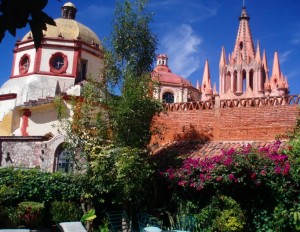 San Miguel de Allende is located in Guanajuato state. It is considered a “Pueblo Magico” (Magical Town) and it is considered Cultural Heritage of Humanity by the UNESCO; the distinction was awarded due to the cultural and architectural contribution to the Mexican Baroque and the importance of this city in the struggle for Independence of Mexico from Spain. The best way to enjoy San Miguel de Allende is walking down the cobblestone streets filled with colonial mansions and beautiful temples such as the Parish of St. Michael the Archangel and the Oratory of St. Philip Neri.
San Miguel de Allende is located in Guanajuato state. It is considered a “Pueblo Magico” (Magical Town) and it is considered Cultural Heritage of Humanity by the UNESCO; the distinction was awarded due to the cultural and architectural contribution to the Mexican Baroque and the importance of this city in the struggle for Independence of Mexico from Spain. The best way to enjoy San Miguel de Allende is walking down the cobblestone streets filled with colonial mansions and beautiful temples such as the Parish of St. Michael the Archangel and the Oratory of St. Philip Neri.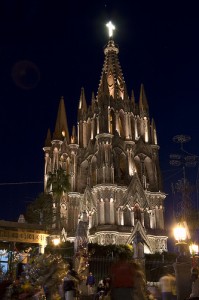
The original Parish of St. Michael the Archangel was built in the late seventeenth century and it was a relatively conventional design and modest. This changed in 1880 when Zeferino Gutierrez a self-taught architect, was commissioned to create a new facade, it is said that he was inspired in drawings, prints and postcards of European cathedrals. The result was a neo-Gothic church, whose towers can be seen from almost anywhere in the city, making the parish one of the most photographed churches in Mexico. The construction of the Oratory of St. Philip Neri began in 1712, the original chapel is the part that faces east of the oratory, and the more modern baroque facade is made of soft pink stone and is overlooking the south. The Chapel has a replica of the Santa Casa in Italy. It is famous for its decoration, walls and golden altars. Inside, exhibits more than 30 oil paintings from Miguel Cabrera.
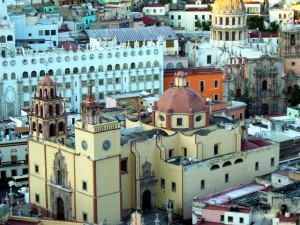 The Temple of the Immaculate Conception is known locally as “The Nuns”, was originally built as part of a large housing complex, and remains now as a convent for nuns of the Order of the Immaculate Conception. The church was built between 1755 and 1842, and the elegant dome was inspired by the Church of “Les Invalides” in the city of Paris, inside preserves a collection of paintings of famous artist Juan Rodriguez Juarez. Some other tourist attractions in the city are the main gardens in a square of the city centre. To the east and west are the arches of the portals and colonial buildings; and to the north is the City Hall. The garden attracts visitors to sit down and talk, relax or listen to musicians playing in the central kiosk and enjoy the many parades that pass through.
The Temple of the Immaculate Conception is known locally as “The Nuns”, was originally built as part of a large housing complex, and remains now as a convent for nuns of the Order of the Immaculate Conception. The church was built between 1755 and 1842, and the elegant dome was inspired by the Church of “Les Invalides” in the city of Paris, inside preserves a collection of paintings of famous artist Juan Rodriguez Juarez. Some other tourist attractions in the city are the main gardens in a square of the city centre. To the east and west are the arches of the portals and colonial buildings; and to the north is the City Hall. The garden attracts visitors to sit down and talk, relax or listen to musicians playing in the central kiosk and enjoy the many parades that pass through.
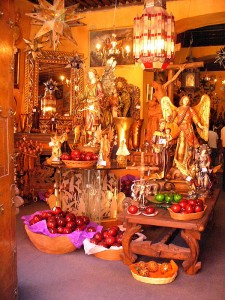 In San Miguel de Allende tourists can find all kinds of typical crafts of the city and some from neighboring towns. The craft market occupies three blocks, filled with stalls selling local handicrafts and folk art, silver jewelry, decorative items, souvenirs, glass objects, gold and brass, woolens, carvings in stone and fine woods, talavera pottery and basketry.
In San Miguel de Allende tourists can find all kinds of typical crafts of the city and some from neighboring towns. The craft market occupies three blocks, filled with stalls selling local handicrafts and folk art, silver jewelry, decorative items, souvenirs, glass objects, gold and brass, woolens, carvings in stone and fine woods, talavera pottery and basketry.
San Miguel de Allende is a monument to tradition and diffusion of world culture, as an example tourists can enjoy the “Sanmiguelada”, inspired by the Spanish Pamplonada celebrated in the month of September, 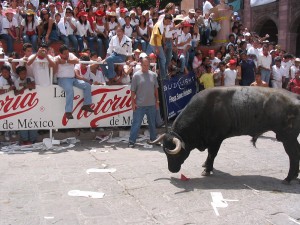 as well as the spectacle of religious feasts of St. Michael the Archangel, and in the St. Anthony in June, both are celebrated with fireworks, music, processions, bullfights. Also there are international art events as the Music Festival or Jazz Festival which have inspired artists and writers to declare themselves the adopted children of this cultural city.
as well as the spectacle of religious feasts of St. Michael the Archangel, and in the St. Anthony in June, both are celebrated with fireworks, music, processions, bullfights. Also there are international art events as the Music Festival or Jazz Festival which have inspired artists and writers to declare themselves the adopted children of this cultural city.
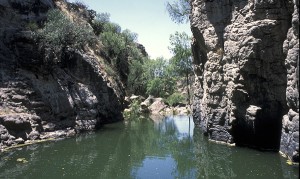 In the surroundings of San Miguel de Allende it is possible to enjoy mountain bike tours, skydiving, hiking or horseback riding, and other activities. The Botanical Garden El Charco del Ingenio is an ecological reserve of over 100 ha for the rescue and protection of wildlife and encouraged the flourish of endangered species. The park has a vast area of Mexican plants, the remains of a colonial aqueduct and an historical reserve, home of native and migratory birds. The whole area is connected by roads ideal for cycling or walking and it is possible to climb the walls of the canyon, and there is also an enclosed park with space for camping.
In the surroundings of San Miguel de Allende it is possible to enjoy mountain bike tours, skydiving, hiking or horseback riding, and other activities. The Botanical Garden El Charco del Ingenio is an ecological reserve of over 100 ha for the rescue and protection of wildlife and encouraged the flourish of endangered species. The park has a vast area of Mexican plants, the remains of a colonial aqueduct and an historical reserve, home of native and migratory birds. The whole area is connected by roads ideal for cycling or walking and it is possible to climb the walls of the canyon, and there is also an enclosed park with space for camping.
Visiting San Miguel de Allende, tourists will find facilities all variety of dishes that offers delicious traditional cuisine from Guanajuato, which invite you to stay and enjoy the warmth of this beautiful village.
